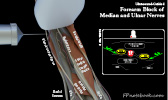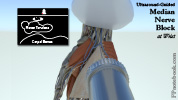Median Nerve Block, Regional Anesthesia of the Median Nerve, Median Nerve Block at Wrist, Forearm Median Nerve Block
- See Also
- Indications
-
Anesthesia of Median Nerve distribution distal to wrist
- Forearm and Wrist Nerve Blocks are primarily sensory (while proximal blocks are also motor)
- Consider in combination with Ulnar Nerve Block at Wrist and Radial Nerve Block at Wrist for Complete Hand Anesthesia
- Contraindications (Relative)
- Precautions
- Avoid Median Nerve
- Injection is harmful if improperly done
- Anatomy
- Relationships
- Flexor carpi radialis (radial side)
- Median Nerve
- Palmaris Longus (Ulnar side)
- Forms palmar aponeurosis at midline of wrist
- Opose thumb and 5th finger to find palmaris longus
- Preparation
- Needle: 23 to 27 gauge 1.5 inch
- Skin Preparation (e.g. Hibiclens or Betadine)
-
Anesthetic
- See Regional Anesthesia for Anesthetic options
- Local Anesthetic 2-5 ml (Ultrasound) or 5-10 ml (landmark)
- Technique
- Forearm (Ultrasound, preferred location compared with wrist)
- Images
-
Ultrasound-Guidance
- High frequency linear probe in short axis
- Use standard Ultrasound-guided Regional Anesthesia technique
- Linear probe is transverse to mid-Forearm
- Median Nerve, Ulnar artery and Ulnar Nerve lie in a plane between the superficial and deep flexors
- Ultrasound at wrist can easily identify ulnar artery and Ulnar Nerve
- Slide probe up Forearm, proximally, until Ulnar Nerve and ulnar artery separate
- Slide probe medially until Median Nerve is seen in the same plane as the Ulnar Nerve
- Needle Insertion
- Both Ulnar Nerve and Median Nerve can be blocked in same Ultrasound view, with needle redirection
- Approaching from ulnar aspect, rounded Forearm edge allows needle to be perpendicular to probe
- May also approach the Median Nerve from the lateral or radial aspect
- Technique
- Wrist
- Images
-
Wrist position
- Forearm supinated
- Dorsiflex wrist to 30 degrees resting on towel roll
-
Ultrasound-Guidance (preferred)
- High frequency linear probe in short axis
- Start with probe over mid-Forearm
- Median Nerve is "starry night" ovoid structure between flexor digitorum superficialis and profundus
- Slide Ultrasound probe distally until a vessel is not adjacent to nerve
- Ultrasound-guided injection site will be proximal to landmark-guided injection
- Use standard Ultrasound-guided Regional Anesthesia technique
- Landmark Injection site
- Proximal wrist crease AND
- Radial side of following landmark
- Wrist midline (1 cm medial to flexor carpi radialis tendon) IF palmaris longus absent OR
- Palmaris longus tendon
- Find by opposing thumb with pinky or
- Flex middle finger against resistance
- Needle insertion
- Apply antiseptic to skin (e.g. Betadine)
- Aim 45 degrees distally toward middle and ring fingers
- Some guidelines recommend directing needle proximally at 45 degrees
- Insert needle 1-2 cm until no resistance
- Do not inject if Paresthesias (see below)
- Warning: Distal Paresthesias with needle with injection
- Indicates needle is at Median Nerve
- Do not inject here!
- Remove needle and replace further to the ulnar side
- References
- Grant and Auyong (2017) Ultrasound Guided Regional Anesthesia, Oxford University Press, New York, 94-103
- Eicken and Rempell (2016) Crit Dec Emerg Med 30(4):3-11
- Pfenninger (1994) Procedures, Mosby, p. 1036-54
- Salam (2004) Am Fam Physician 69(4):896 [PubMed]
- Yurgil (2020) Am Fam Physician 101(11):654-64 [PubMed]


